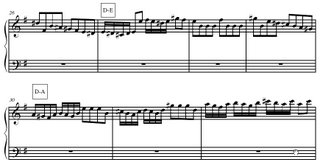A transition has been added to the first subject that takes its lead from the eighth-note figure in the viola:

The transition rises to the 2nd subject, in A major, which includes some chromatic passages borrowed and modified from the beginning:

There is no coda before, as originally intended. Maybe I’ll insert one later, maybe not. It sounds to my ear a bit out of balance, but that is not necessarily bad.
The development works on the 1st subject, starting with the viola and the first two bars in a minor. The 1st violin throws in its four pieces of eight as comments, causing the viola to change its tune, then everyone chimes in until the viola wraps up the section with the 2nd bar.

The 2nd violin takes the 2nd bar to C major and noodles its way to the third bar with some echoes from the first fiddle.

Then the cello takes over, putting the 3rd bar into G major with some conviction, which the 1st violin softly echoes on high, from which everyone tumbles down

to the viola and the 4th and 5th bars in D major. The viola then launches into some noodling of its own for a short trip to b minor and a handoff to the 2nd violin.

The 2nd violin decides there has been enough noodles of late and takes bars 5 and 6 from the 1st subject and spins some variants:

The cello likes that idea and takes the 6th bar, now in f# minor, tosses it around on the way to the 7th bar.

The 1st violin, having allowed the others to dominate the development, states the opening chromatic figure on A major, passes it to the cello, who hands off to the 2nd fiddle, who returns the passage to the 1st to complete a dominant seventh and start the recap.







































